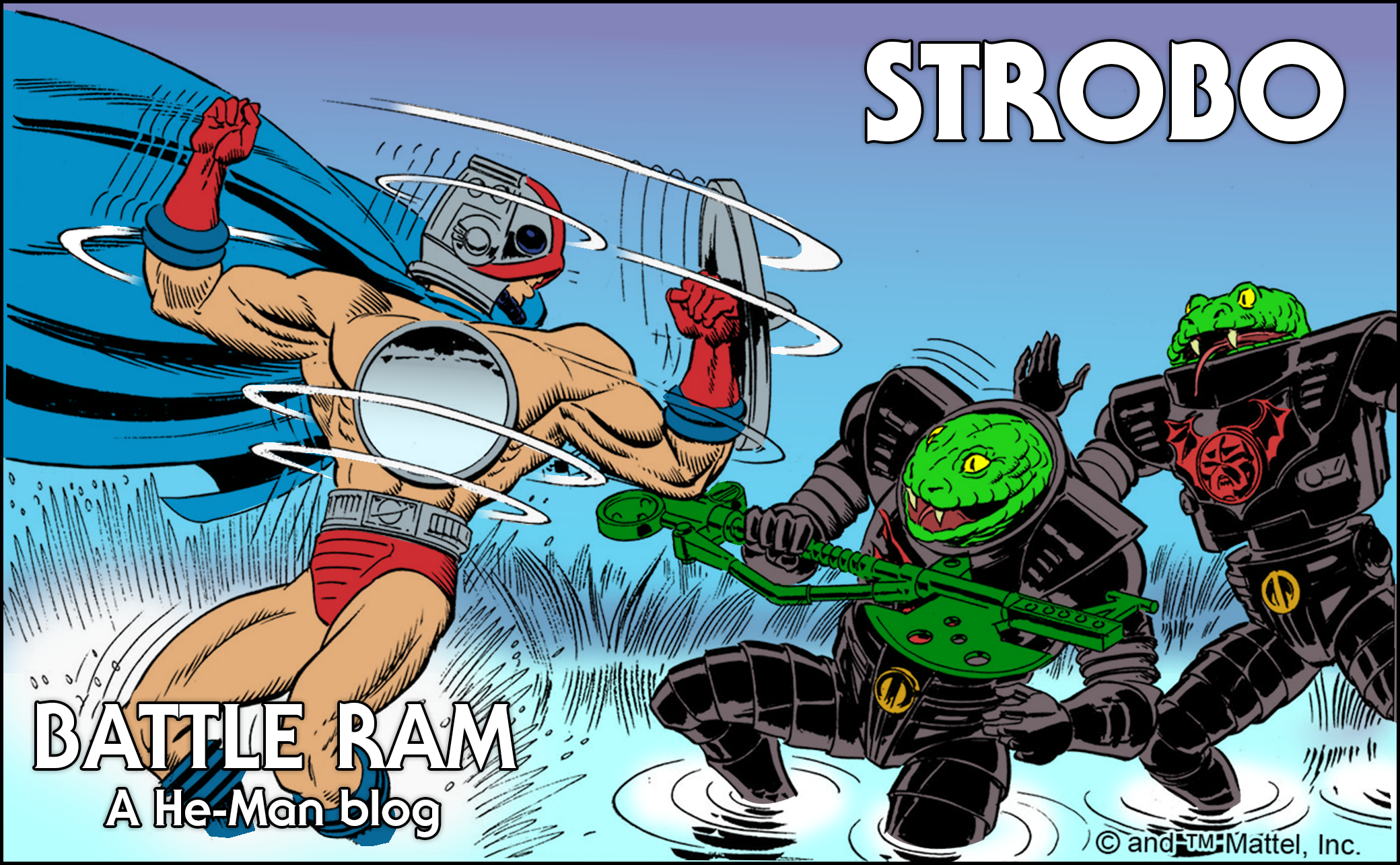
Article by Jukka Issakainen and Adam McCombs
Although never advertised in catalogs, in the late 1980s Mattel had plans to release a wave of figures that would feature 100% reused tooling, the vein of previous characters like Stinkor, Moss Man and Faker. Presumably these figures would have been released in 1988 along with Laser-Light Skeletor and Laser Power He-Man. Six figures made it far enough in the design process for Mattel to commission packaging artwork for them, although of the six, only Strobo had an appearance in vintage media.
Cardback illustration
Strobo appears in two separate pieces of cardback artwork by Errol McCarthy. One was created for Strobo’s packaging, and the other for a Snake Trooper army builder character.

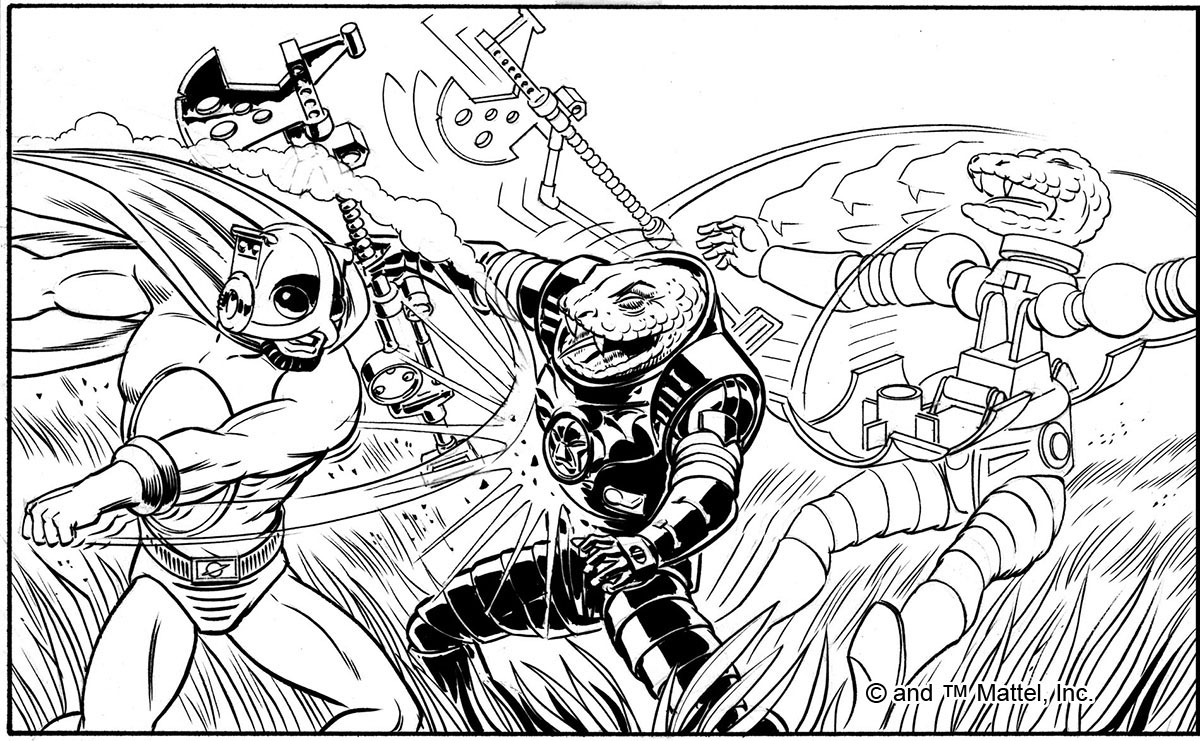
The illustration below shows which parts Strobo would have been built from:
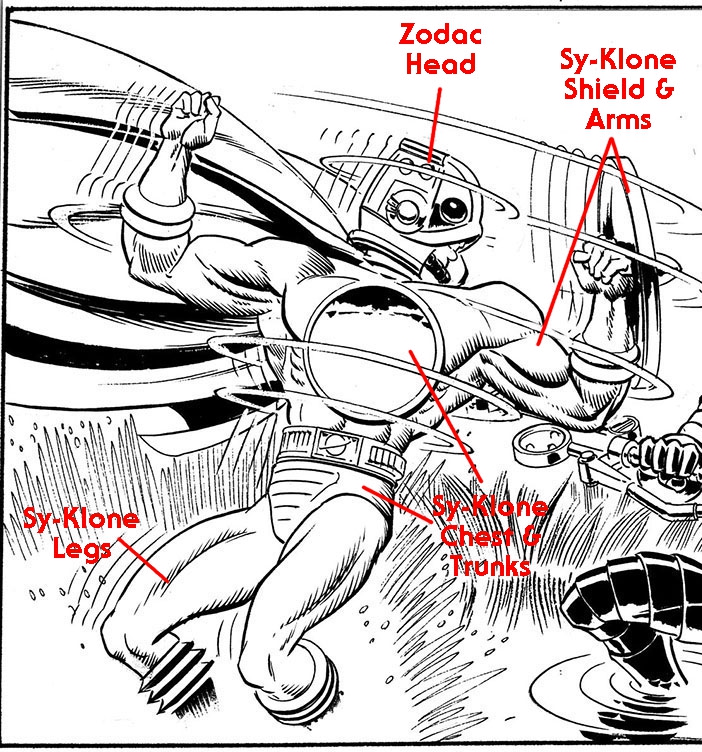
Interestingly, Strobo’s arms look like Sy-Klone’s arms except for the fins on the outer arms. It’s not clear if this figure would have omitted those fins as depicted in the artwork, or if Errol was displaying a bit of creative license in his illustration.

US Magazine – Masters of the Universe
Strobo appeared in the Fall 1988 issue of Masters of the Universe Magazine, in a story called The Dark Power of Skeletor. The story is really the continuation of a story arc that started with the Spring 1988 issue story, To Save a World. In that comic, a rogue dark star comes close to Eternia in a rare event. Skeletor tries to harness its power, but in the process almost destroys all of Eternia. Only by He-Man and Skeletor working together is Eternia saved from utter destruction.
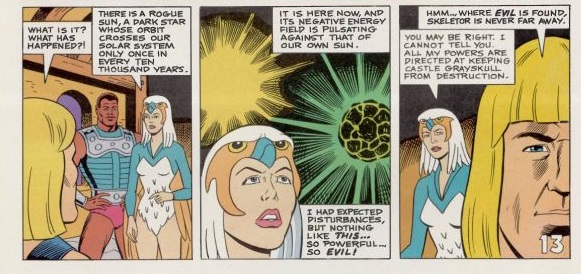
In The Dark Power of Skeletor, we learn that a meteor from the dark star had landed on Eternia, and Skeletor used its power to cast a shadow over the land. Anything in the shadow, including Castle Grayskull, was under Skeletor’s control. We find him and his evil warriors occupying the throne room of Castle Grayskull, which is illustrated in the Filmation style. Sorceress in her Zoar form is locked in a bird cage. In order to break the shadow magic, He-Man shines light from his sword onto Strobo’s chest. Strobo spins, bathing the room in light and causing the piece of the dark star to explode into dust.
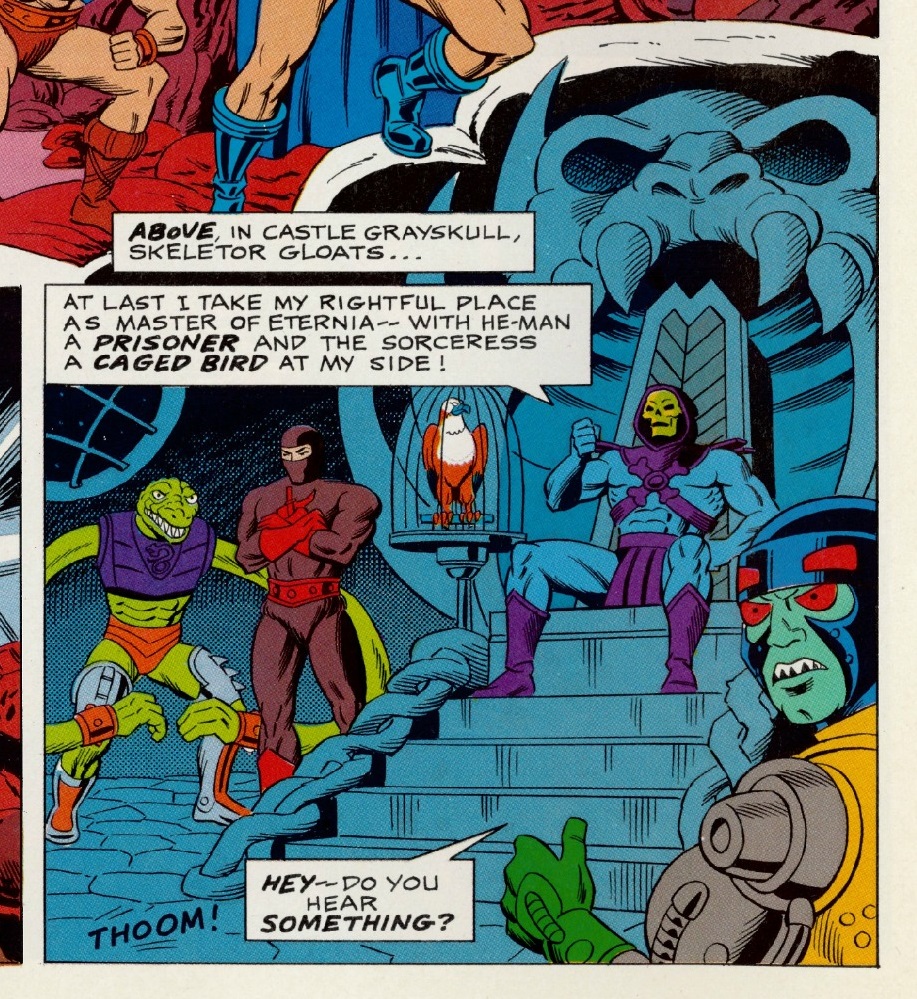



Full story below:
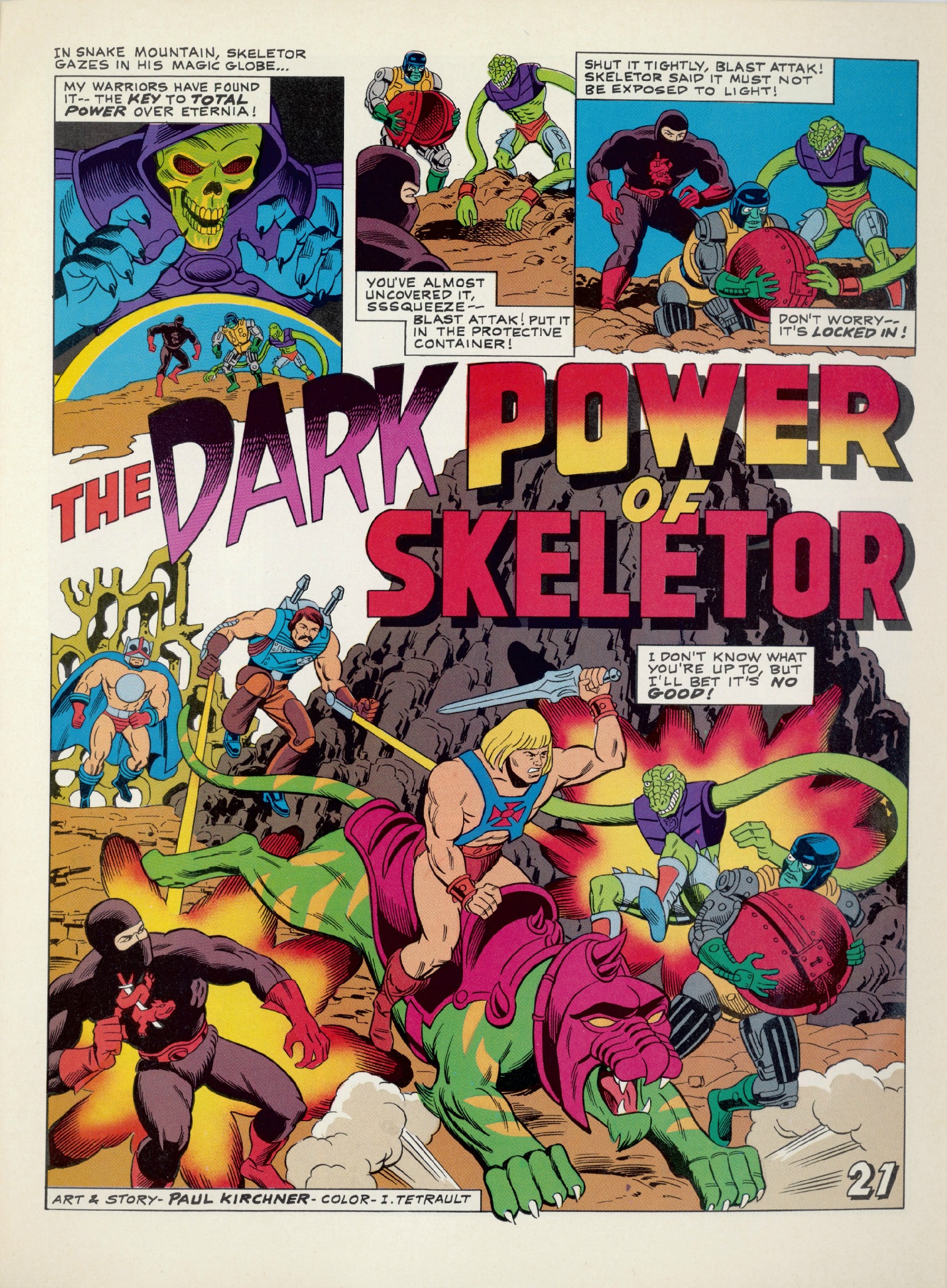
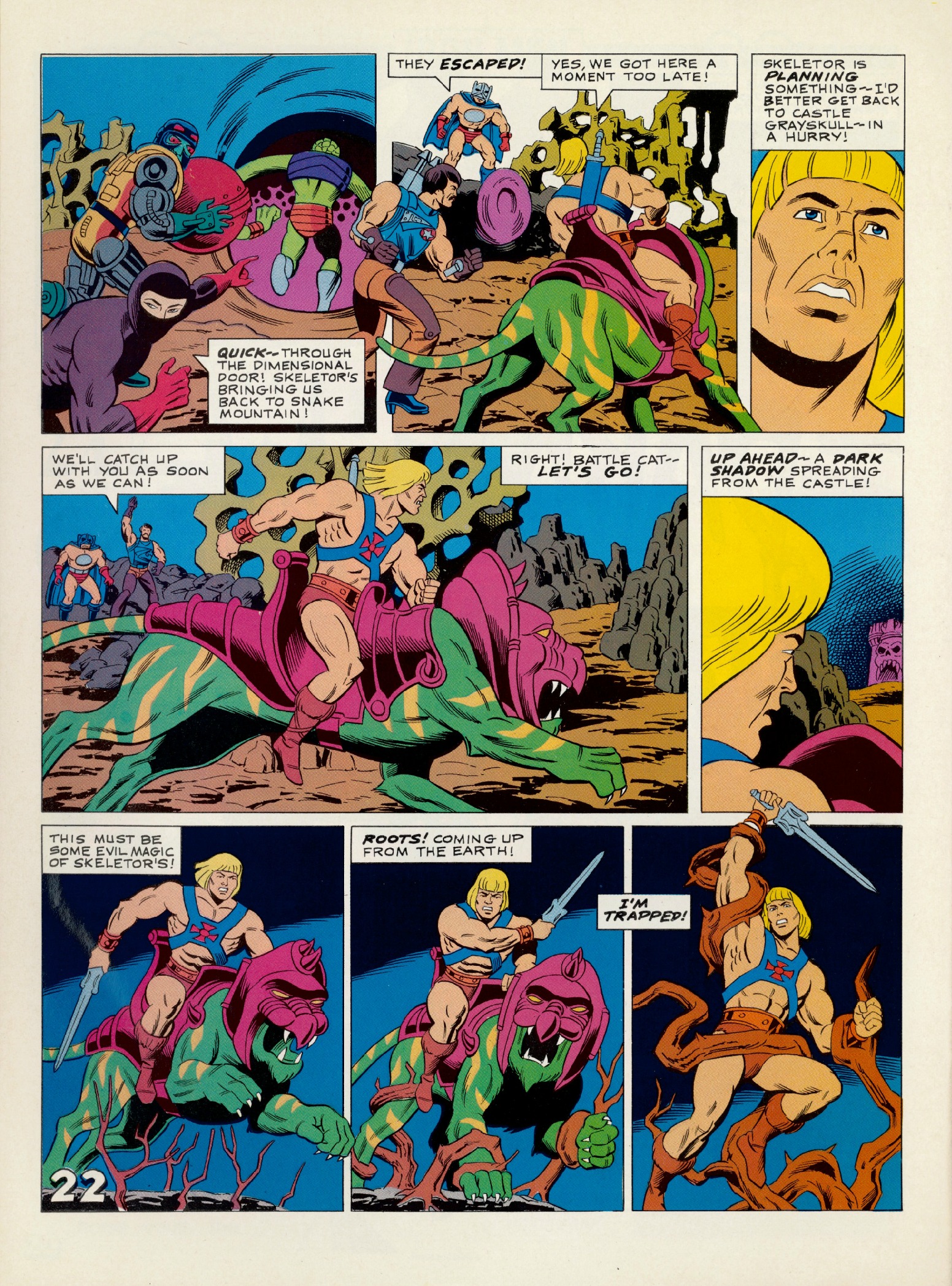
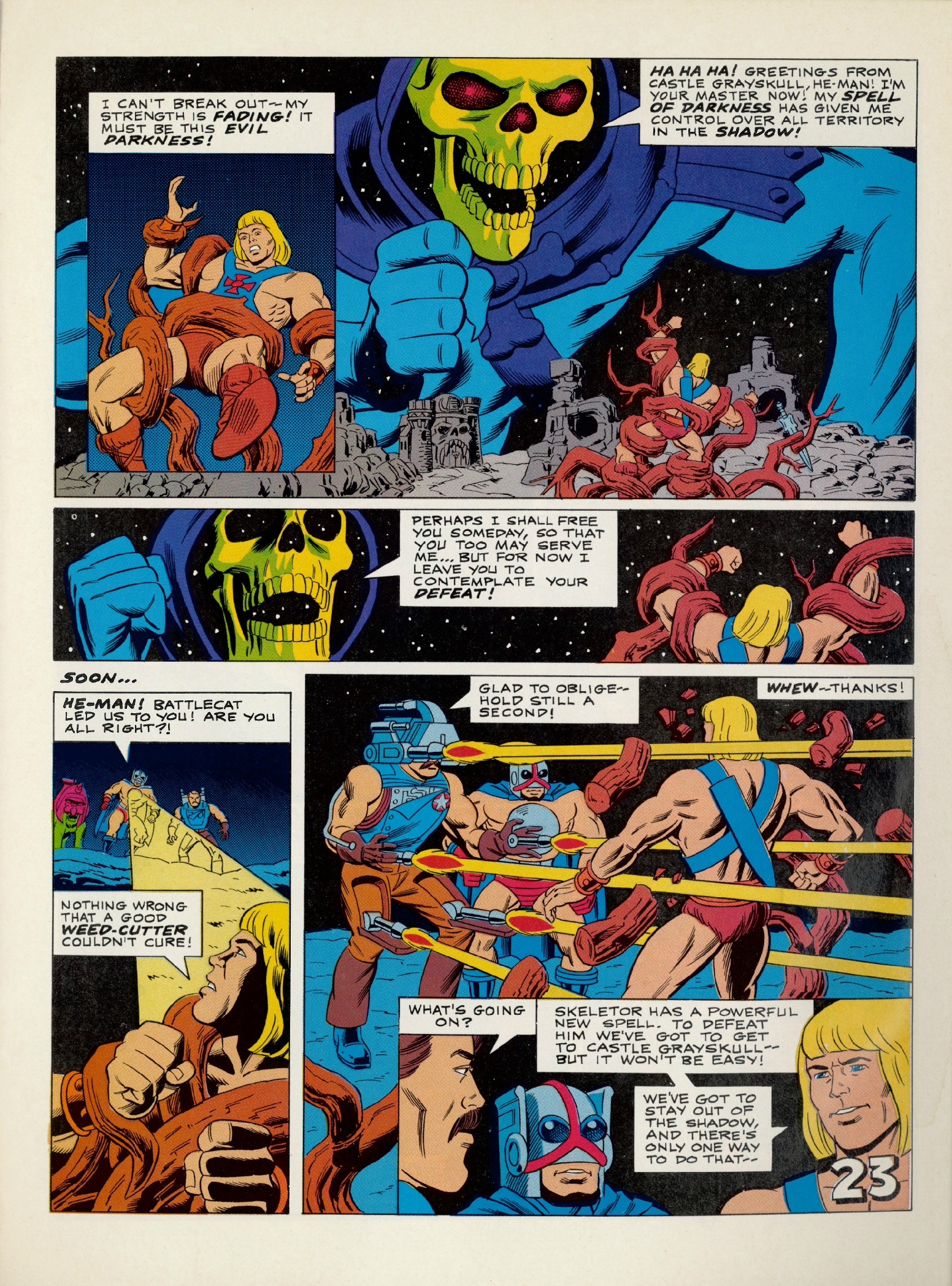
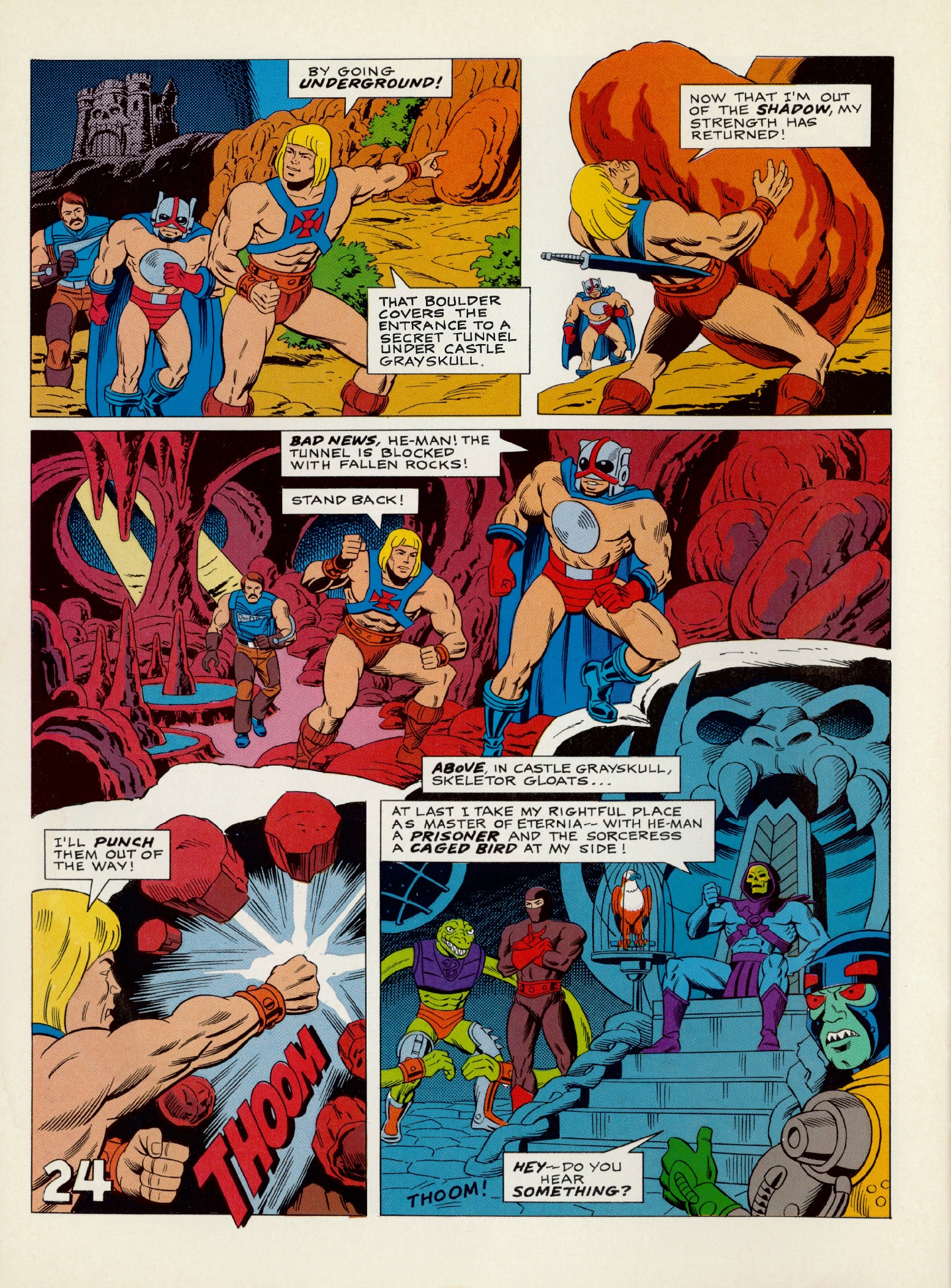


Note that despite Strobo’s Zodac helmet, there is no mention of his being a Cosmic Enforcer or there having been any connection between himself and Zodac.
So if Strobo was not originally intended to be a Cosmic Enforcer, what lead him to that road?
In the original Filmation He-Man and the Masters of the Universe show, Zodac appears three times. He is portrayed as the Cosmic Enforcer that watches over the Universe. He is not good or evil in the cartoon; we seen an example of that when he gives Skeletor the knowledge of how to obtain the Starseed (“The Search”) which serves as a test for He-Man. But his presence is requested at times when the balance is tipped (“The Quest for He-man”) so fans see him help out the good guys. In the episode “The Golden Disks of Knowledge,” it is revealed that Zodac is the last member of the Council of Wise.
[High-Definition Filmation screencaptures by Jukka Issakainen]
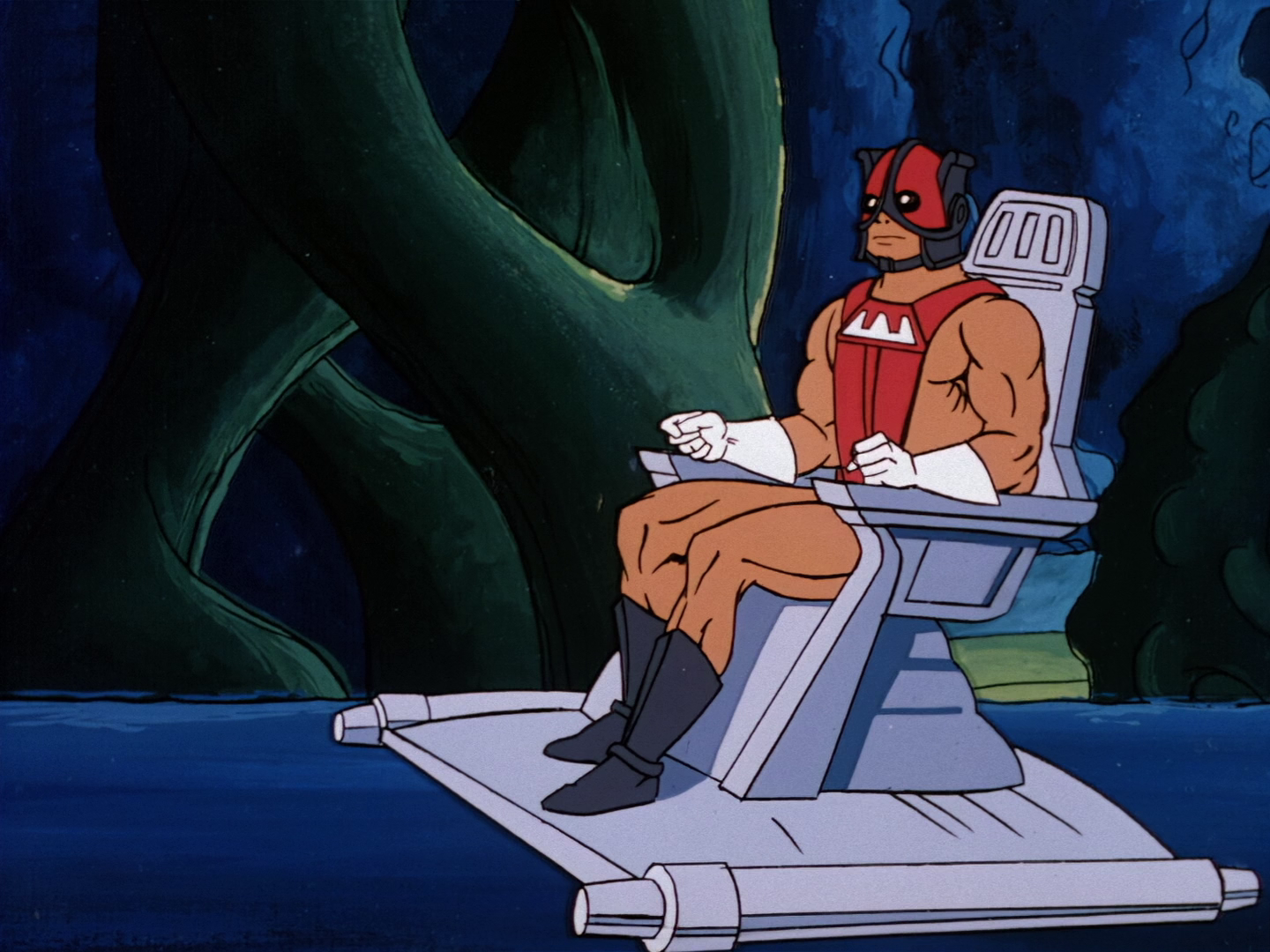
Zodac was also part of the group decision, that sent Zanthor into the Phantom Dimension as punishment for his crimes. Zanthor in his greed had given the Golden Discs to Skeletor. Having had a change of heart, Zanthor wants to atone for his crimes, so he pleads to help retrieve them back as penance. Zodac is called for this occasion and he decides to set Zanthor free from the Phantom Dimension, but only as a ghostly figure. With help from He-Man, they manage to get the Discs back from Snake Mountain.
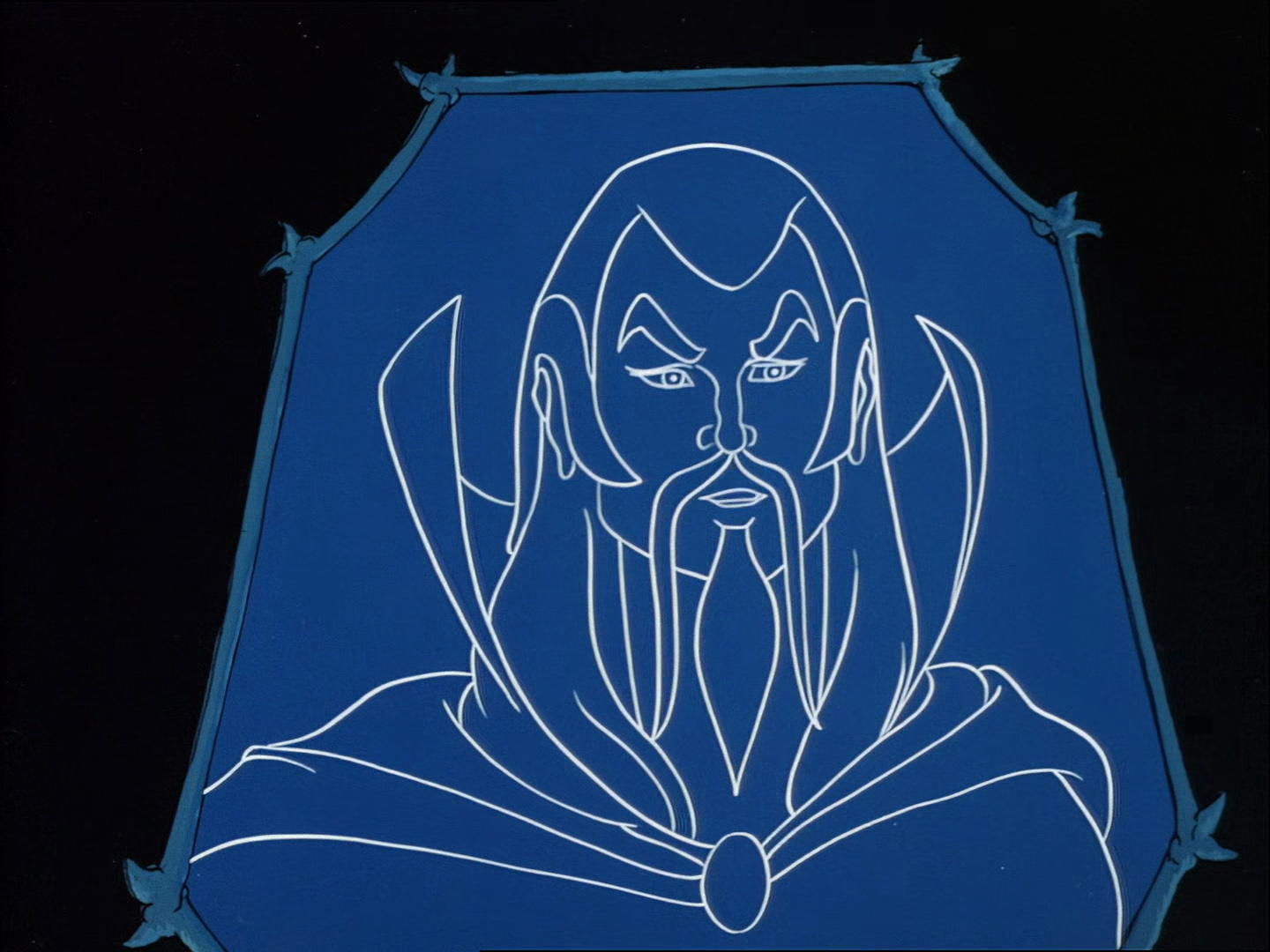
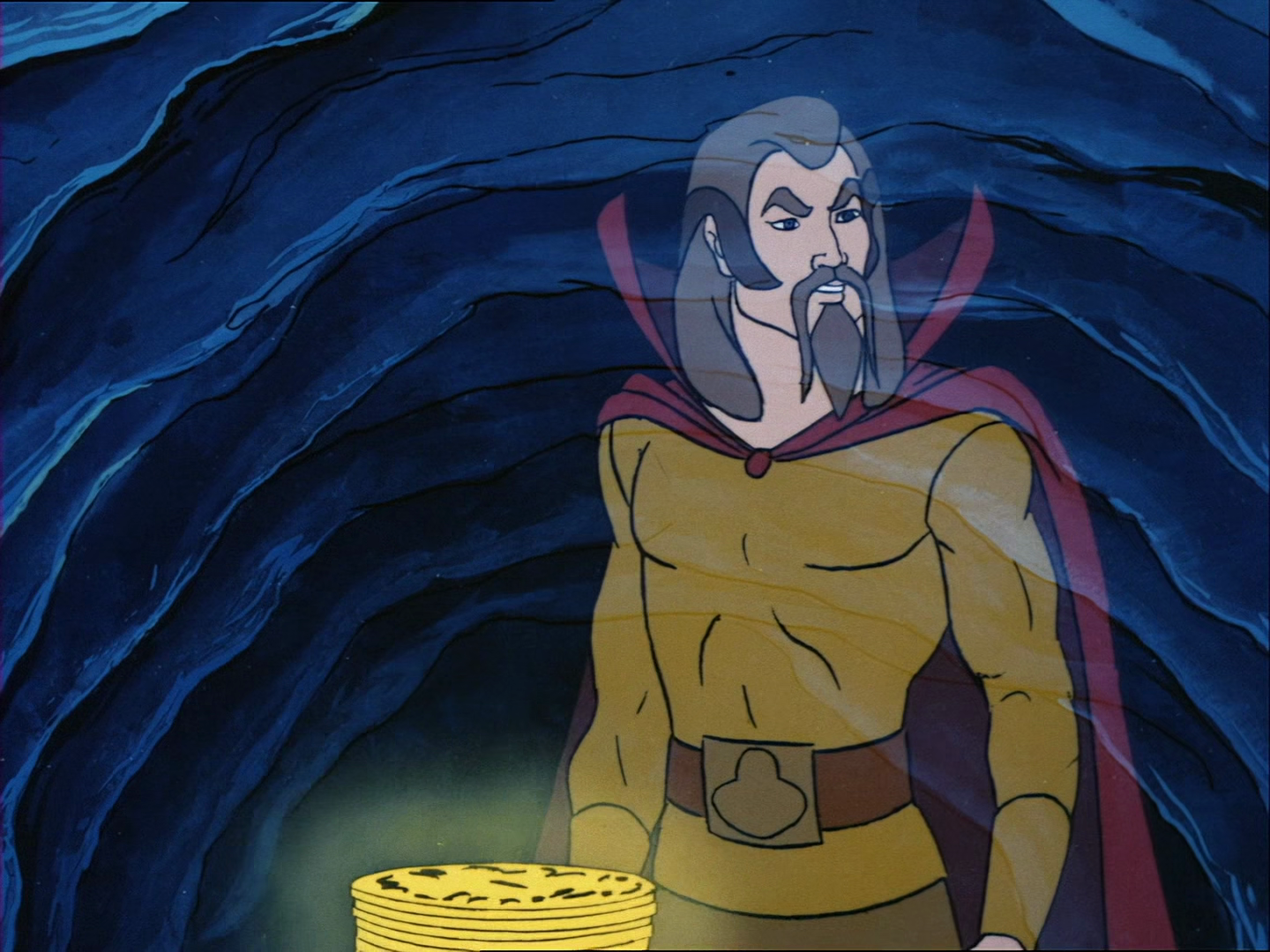
After they have retrieved the Golden Disks of Knowledge, Zodac says that he will need some help, and turns Zanthor from his ghostly form into a Cosmic Enforcer.

We now see Zanthor sporting the same red armor, dark gray boots, white gloves and red helmet that Zodac wears. From this episode the precedence is set that if you join the Cosmic Enforcers, that armor and red helmet are part of the uniform. They embark on their journey together, each turning into a white ball of energy as they bid farewell to He-Man and the other heroes.
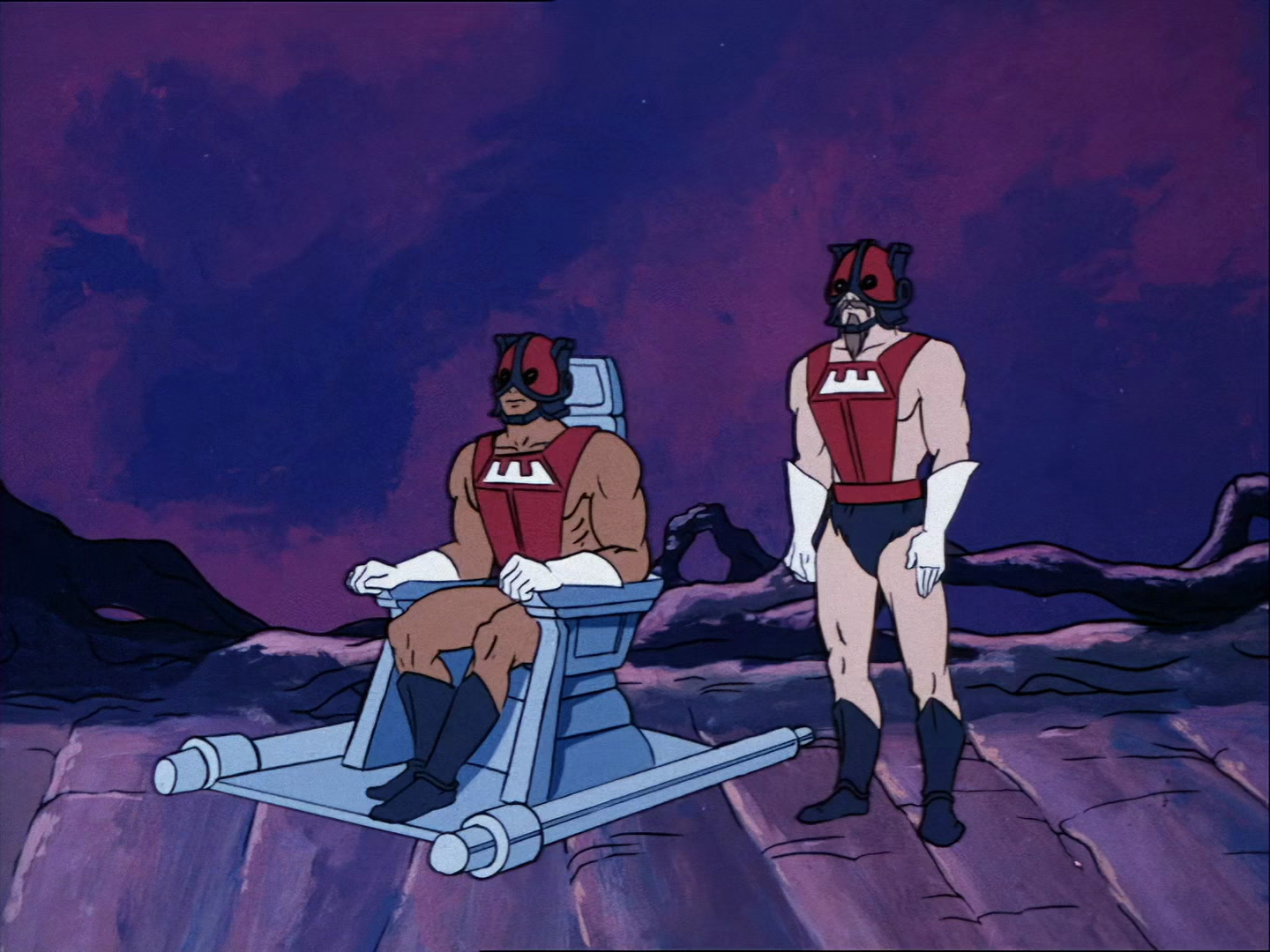
It doesn’t seem that Mattel made the connection with Zodac’s helmet and the Cosmic Enforcers when they were creating Strobo. Indeed, Strobo seems to have more in common with Sy-Klone than Zodac. The canon of Masters of the Universe was never tightly controlled, and it was rebooted several times, even in the 1980s. The people who developed Strobo may not have even known about “The Golden Discs of Knowledge.” And of course in some 80s media Zodac had been retconned as an Evil Warrior. Strobo’s name and main gimmick with a reflecting light in the magazine story demonstrates that the approach was more leaning to the Sy-Klone direction, and not as a member of the Cosmic Enforcers.
Masters of the Universe Classics toyline
Strobo was released in the Masters of the Universe Classics Toyline as a traveling convention figure, periodically made available online and at conventions throughout 2013. Because the source material at the time was only the MOTU Magazine story and not the Errol McCarthy art (which hadn’t been revealed yet), Strobo was not released with a repainted Sy-Klone shield. Instead he came with a piece of the dark star, complete with stand, and an extra unhelmeted head intended for Zodak, the 200x Cosmic Enforcer. He was supposed to come with a Four Horsemen-created strobelight gun as well, but it was cut for cost. Later it would be released in a weapons pack.
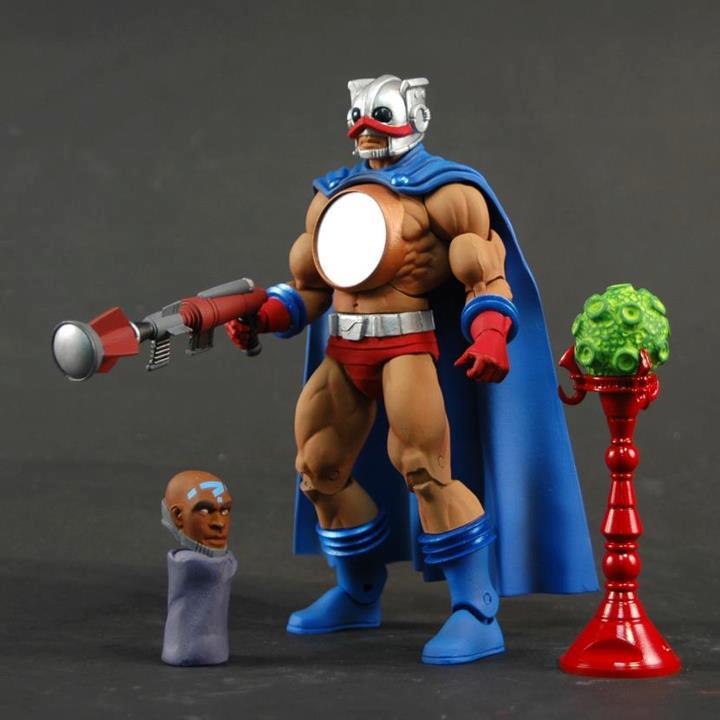
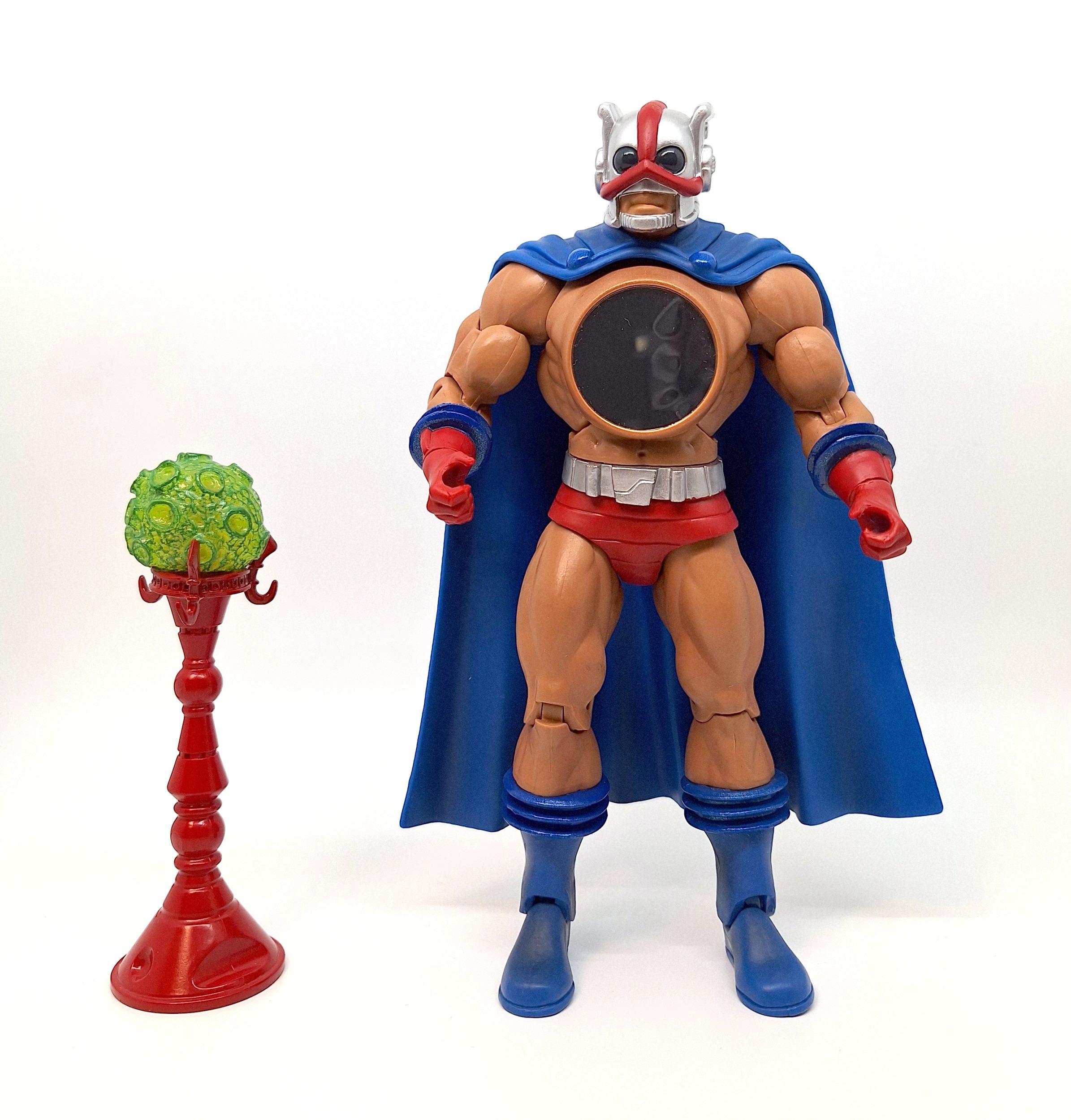
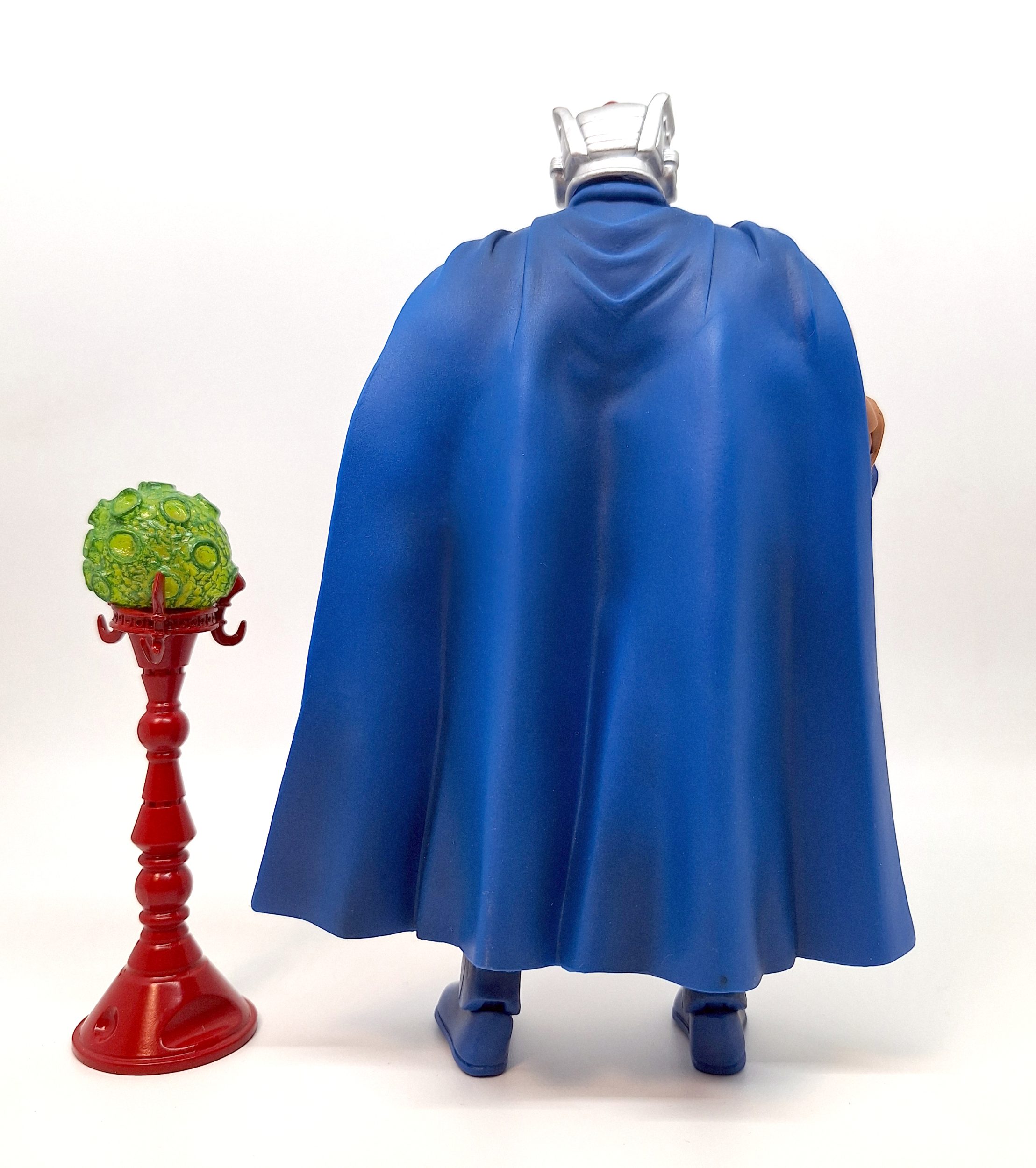
In the bio that came with Strobo, he was re-written as the Cosmic Enforcer who replaced Zodac after his death (there were a lot of deaths in the MOTU Classics bios). The bio says he was “forcefully maintaining neutrality in He-Man’s absence” which sounds like a contradiction in terms. Bits and pieces of the bios have been used in more recent story canons, and the aspect of Strobo being a Cosmic Enforcer is one element that carried forward. The “real name” was invented for the Classics line, and has not been used in any media after it.
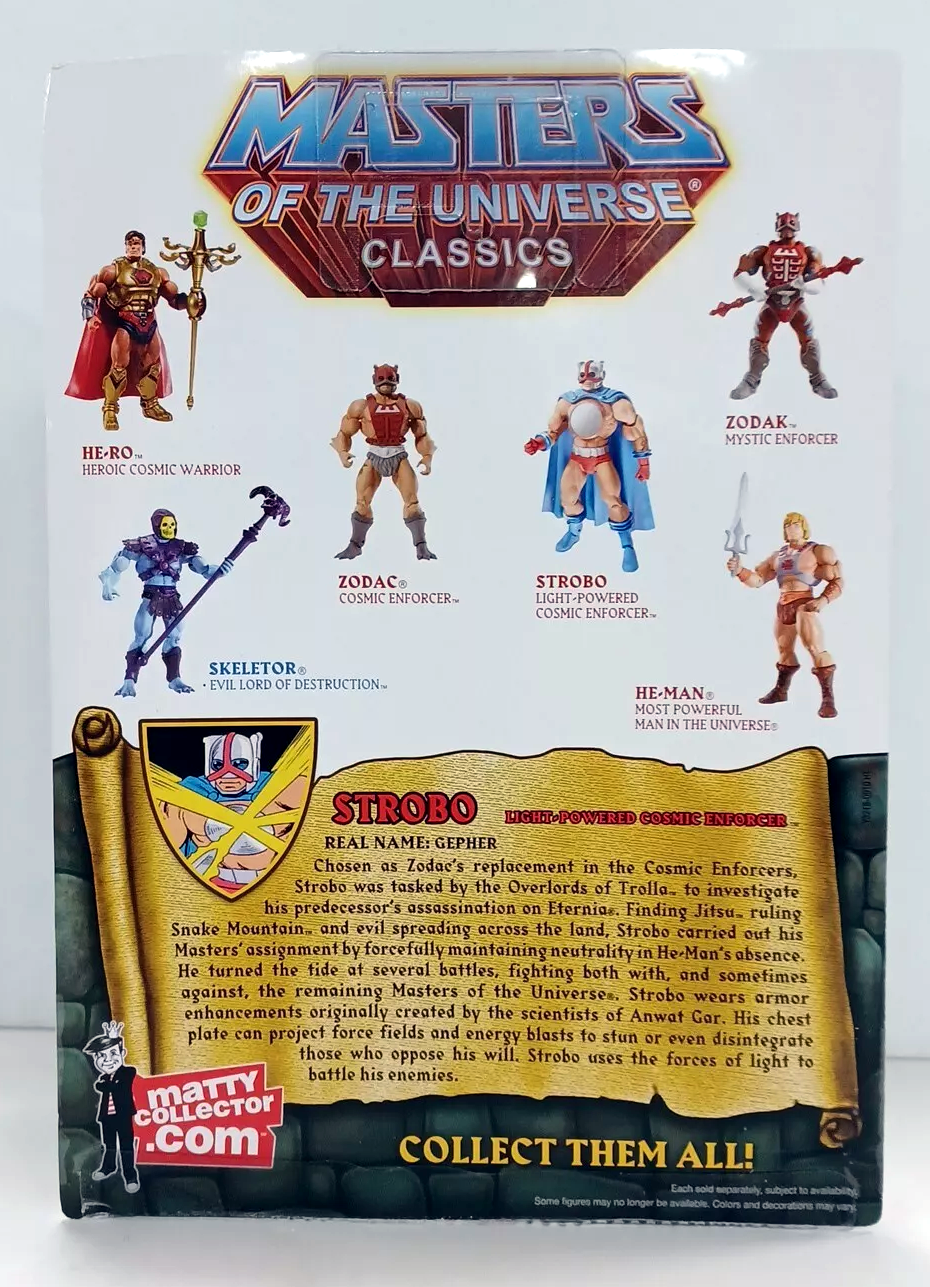
Since Strobo was a Traveling Convention Exclusive figure by Mattel, German fans found a cool way to advertise him on the back cover to the Grayskull Convention 2013 exclusive minicomic “Under Grayskull’s Flag” (art by Daniele “Danbrenus” Spezzani).
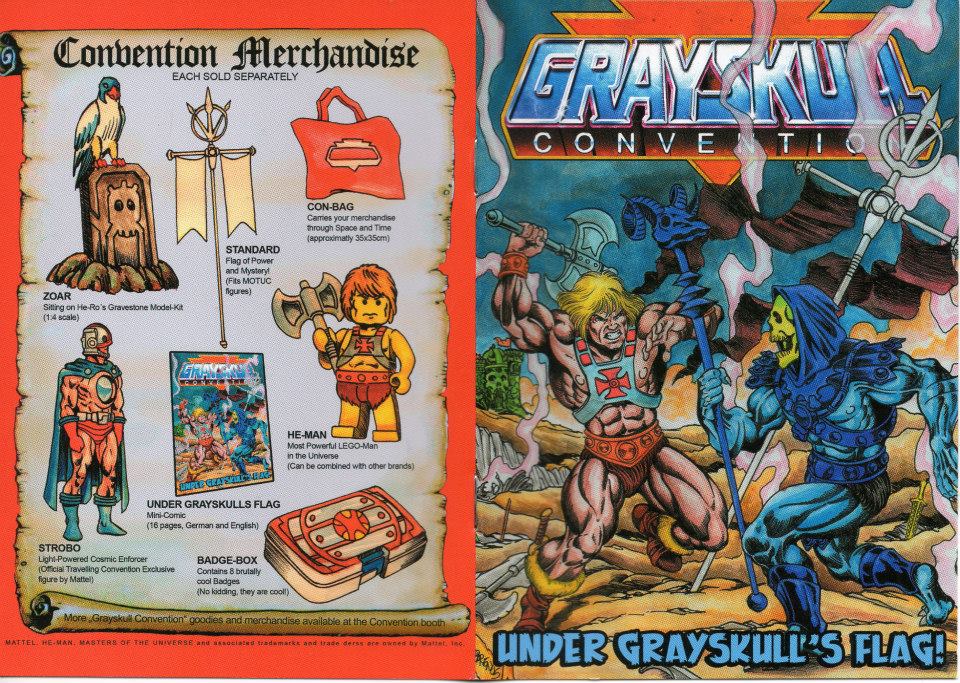
Classics Mini-Comics
Below is the original pencil layout page spread for MOTU Classics mini-comic issue #8 by Axel Giménez, where Strobo is included close to King He-Man and Orko in the battle scene.
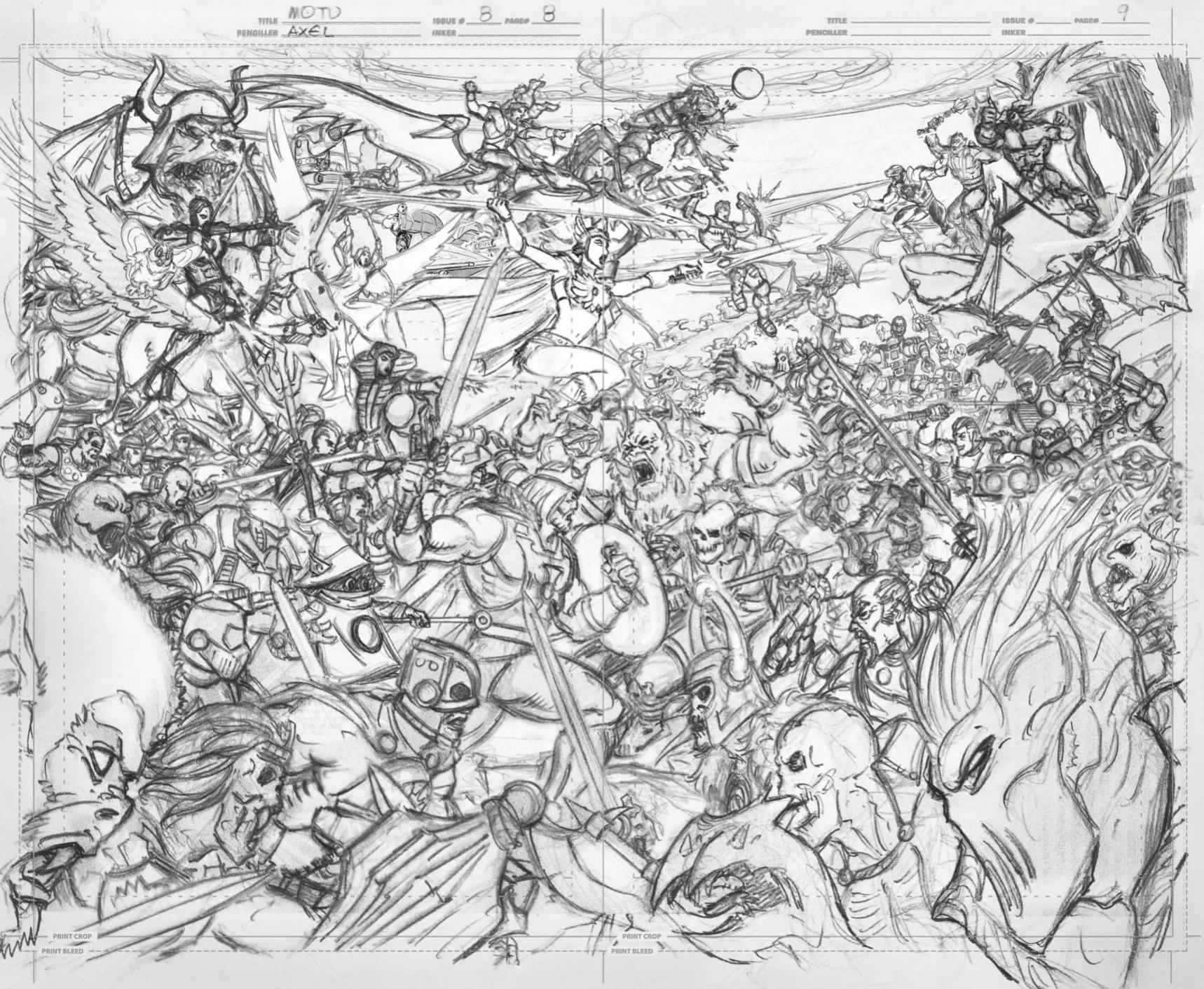
Final artwork altered and omitted some characters. Artwork by Jordi Tarragona and color by Carrie Strachan.

The coloring on Strobo’s helmet appears to be based on the Classics prototype version, where the middle line across the helmet is not colored red.
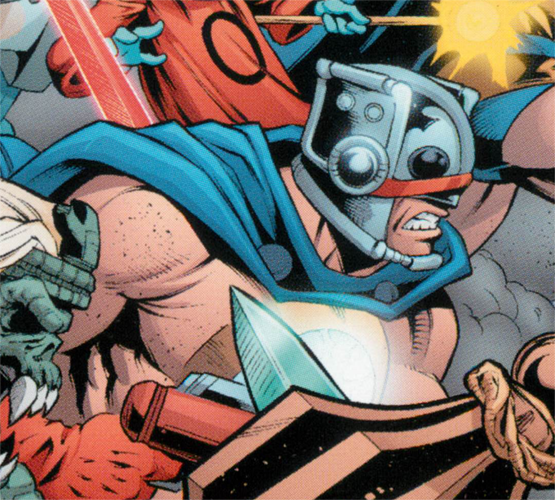
DC Comics
A brief appearance for Strobo occurs in the He-Man and the Masters of the Multiverse comic mini-series from DC Comics issue #3. This is the first time that after the Classics toyline associated Strobo as part of the Cosmic Enforcers, that it is acknowledged in another media outside of it. Art by Dan Fraga & color by Matt Yackey.
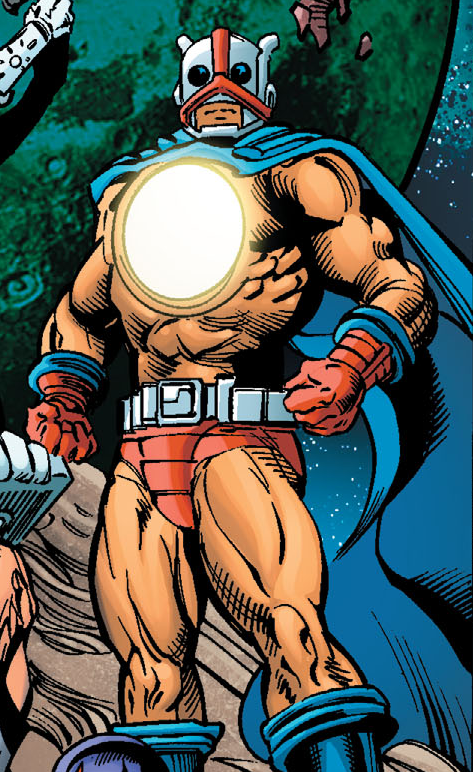
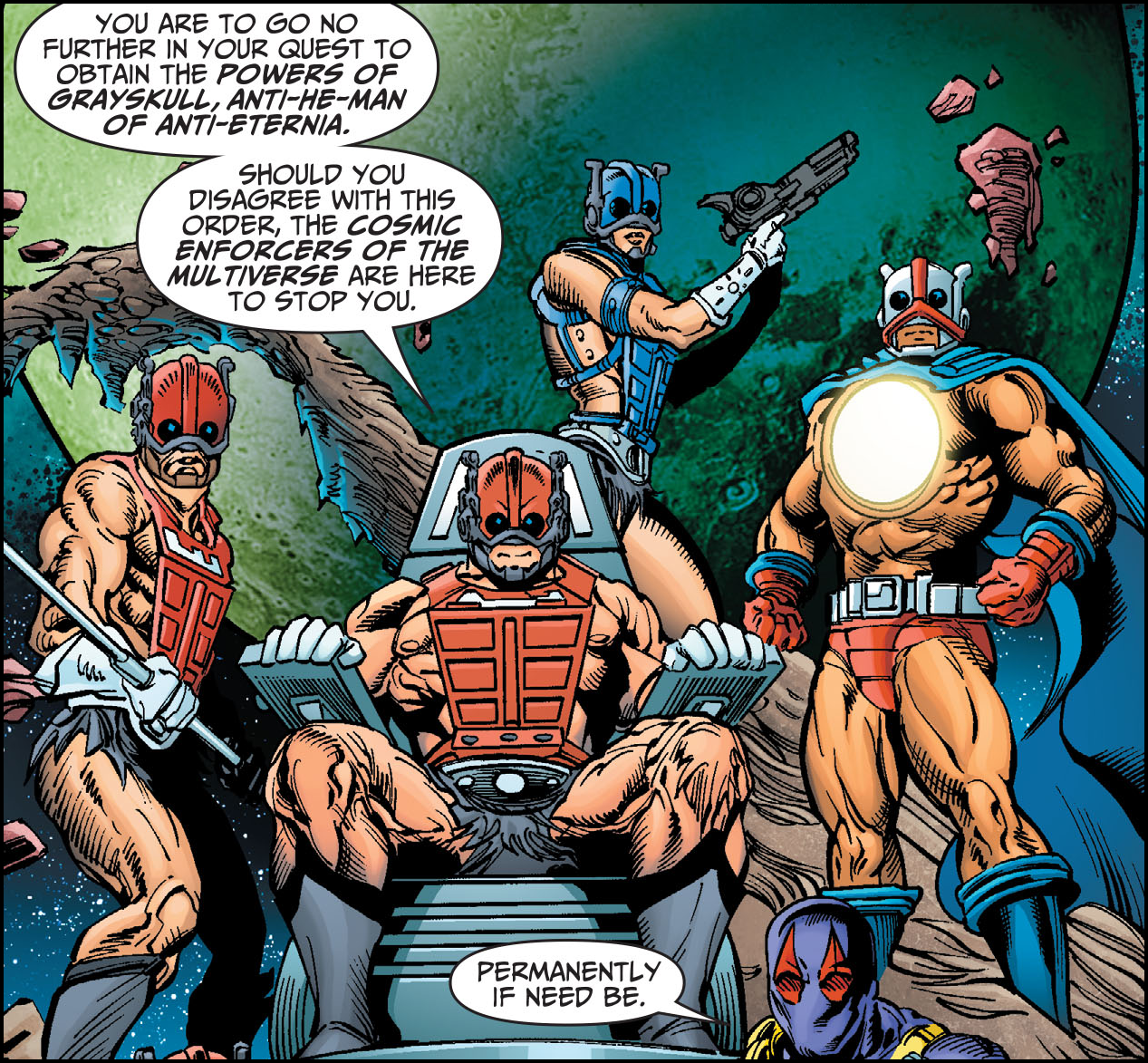
As the Anti-Eternia He-Man is on his quest, he is stopped at the Interrealm by Zodac, Zanthor, Strobo, Apokrifa, Zodak and the Mighty Spector. Though in the next page it appears that Anti-Eternia He-Man prevailed against the Cosmic Enforcers of the Multiverse and continues on his rampage.
Masters of the Universe Revolution
In the Netflix animated series Masters of the Universe Revolution, we catch a glimpse of Zodac speaking to Evil-Lyn in episode 05. And next to Zodac (on his right side) is Zanthor and on the other side is Strobo. Neither Zanthor nor Strobo have any dialogue in this ending teaser.

In a close up shot of Strobo, it appears that his right hand is not wearing the red glove. But that might just be a small coloring error.
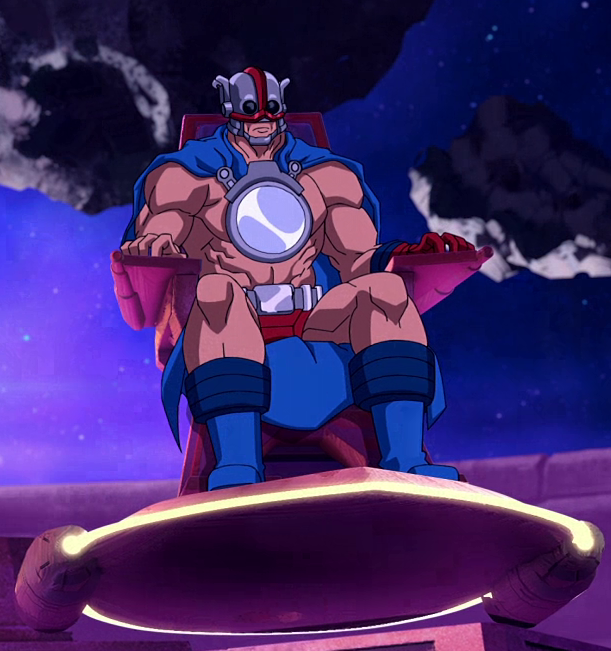
Thank you to the following individuals who are current Patreon supporters!
- Adam A.
- Allison T.
- Ben M.
- Eric H.
- João S.
- Jon E.
- Max I.
- MotuOriginsCork
- Orion W.
- Øyvind M.
- Philip O.
- Robert B.
- That Clyde Guy
Want to support the blog? Consider becoming a Patreon supporter. You’ll also gain access to exclusive content and early access to posts on the blog. Thank you!
Thank you for another great article.
MOTU was a wonderfully crazy line that, in one instance, would reuse bucks, then release a slew of unique body types for the Horde, Snake Men and later characters such as Dragstor and Rio Blast.
That Strobo really is a hideous design, though. They get the prize for that one!
Why not just do an evil version of Sy-Klone (play up on the clone part), with a new, monstrous head sculpt?
No one had forgotten about Zodac. To reuse his distinctive head was just lazy. Unlike Stinkor (poor Mer Man never looked aquatic) and flocked-headed Moss Man, it was always going to look like Zodac.
To me, between the colors and buck choices, Strobo, Lord Grasp and Terroar all look like bad kit bash nightmares.
Thank you! I kind of like Strobo because he’s so kooky looking, like a low-budget sci fi movie character. In general I’m not too fond of the other 1988 kit bash designs, though.
The “lazy kit bash” thing was pretty much intentional, though. These were very late in the day, wringing-the-last-drop out of the toyline figures, as I understand it pretty much aimed at the European (/other international market), where releases were generally a few months to a year behind the US ones, and whereas MOTU’s popularity had pretty much finished in the US by this time, they were still on their late-in-the-day popularity elsewhere and the late figures were still selling (that certainly was the case here in the U.K.).
So these “final wave” characters were literally designed for every single part to be recycled from previous figures, and – with respect to Mattel – probably not a whole lot of thought or effort into giving them a major amount of depth as compared to earlier characters. Of course, the idea fell through when international sales also dropped off. The idea of an evil Sy-Klone is a pretty cool one, but even the commissioning of a new head sculpt for it would have been outside of the criteria for that low budget final line.
But yes, literally everyone of that proposed final wave looks hideous mash-ups. For me, they only have novelty/interest value for the reasoning behind them. I can’t say any of them I would have rushed out to buy back in the day, as they are literally just cheap mash-up / repaints of older characters. ….Then again, my favourite vintage figure is generally Faker, so I’m somewhat of a hypocrite on that one!! 🙂
Yeah, there’s something about Faker! I remember getting him as a gift, no artwork on the card back, no advertising/commercials, no mention in the mini comics, no heroic counterpart figure released at the same time (I recall them releasing new good guys and bad guys 1 to 1). Just this random robot He-Man that dropped out of the “blue”!
The chest sticker was cool, too, and I guess reminded me of the interior Castle Grayshull artwork, like the last tie-in to that era before the cartoon took over.
I think the strength of Faker’s appeal is still in that first He-Man design. The famous MOTU body type, but that He-Man head sculpt really is iconic.
I can see why people thought MOTU started as a “Conan” tie-in, because his face is vaguely Arnold, but then, tough to pin down. I heard a European artist and MOTU fan describe the face as “Mongolian.”
In an odd way, he’s not race specific, he just looks “barbarian.”
The wordplay comes from cyclone. There has been no indication that Sy-Klone has clones of any kind though.
Though would be curious to see an evil counterpart for Sy-Klone 🙂
Great article! Thank you!
For some reason, I never got the last issue or two of the MOTU Magazine, so I knew nothing about this guy until the early 2000s or so. In the end, I got the Classics figure, and it’s nifty to see how he has been included since then.
Oh gee were there a lot of unnecessary deaths in the Bios back in the day. I guess that’s one way to try and make a couple lines on the back of toy packaging seem more dramatic; but it never felt like anything other than an attempt to make stuff “edgy.”
I have such an affection for the entire Lost Wave and as they are slowly trickling out in Origins am feeling excited about having a complete set of them… Walmart Exclusives be damned.
Nice article on the whole, but there is a glaring error about the original alignment of Zodac. It’s misleading to say he was “retconned as an Evil Warrior.” Zodac was originally intended by Mark Taylor to be on the heroic side, but was switched to the Evil side by Mattel (along with other characters switching sides a few times, Stratos, Mer-Man etc.). Zodac was released as an Evil warrior in the original toy line, as the 4th Evil Warrior, clearly defined as such in his later card art. It was the DC comics that retconned Zodac into being a “neutral” character, for their MOTU comic. This retconned idea was then continued into the Filmation cartoon series. The idea of him being neutral became the most established one, but not the original idea, far from it. In the UK Ladybird books, Zodac is shown as an Evil Warrior, which reflects his alignment in the toy line. But if we call that a retcon then the neutral DC comics & Filmation version of Zodac is also a retcon of Mark Taylor’s original heroic character.
Mattel positioned Zodac as an Evil Cosmic Enforcer starting in 1983, but prior to that he was called a neutral cosmic enforcer in the 1982 DC comics series, which were his first appearance in any media.
The 1982 figure packaging does not specify whether he is either good or evil (he is just called Cosmic Enforcer on the 1982 cards), nor does his description in Mattel’s 1982 catalog specify any affiliation. In some comics he is good, evil or neutral, depending on the comic. It’s never been consistent. I covered the history in a video and in another article:
https://youtu.be/YXLbQtXe7k8
https://battleramblog.com/zodac-cosmic-enforcer-1982/
Sorry but you’re incorrect in your articles. The original intention of Mattel was to release 4 Heroic Warriors and 4 Evil Warriors in the toy line. This is why there were characters switching sides in the pre-MOTU material, such as The Fighting Foe-Men, where Mer-Man was switched to the good side, and Lords of Power, where Stratos was moved to the evil side (later reflected in the Mattel licencing kit, and carried over into the 1st minicomic). Those characters were later switched back to their original positions at different times. Zodac was added to the Evil Warriors by Mattel to replace Stratos, who was moved back to the Heroic Warriors, when The Sorceress (Goddess) was combined with Teela into one female figure, on the good side. Thus, a space was left for a 4th Evil Warrior, which was released as Zodac. That’s the only logical sense that can be made of events. The fact that the later card backs listed Zodac specifically as evil, only goes to illustrate what Mattel were originally intending.
“Sorry but you’re incorrect in your articles. The original intention of Mattel was to release 4 Heroic Warriors and 4 Evil Warriors in the toy line. ”
I’m not aware of any documentary evidence that supports the claim that anyone at Mattel originally intended for Zodac to be an evil warrior. Even as late as December 1982, Mattel commissioned Michael Halperin to write the MOTU Bible, in which Zodac was again a neutral character.
By moving Zodac to the evil warriors in 1983, they actually overbalanced on the evil side, leaving 6 heroic warriors (He-Man, Teela, Man-At-Arms, Stratos, Ram Man, Man-E-Faces) and 8 evil warriors (Skeletor, Beast Man, Mer-Man, Zodac, Faker, Evil-Lyn, Tri-Klops, Trap Jaw). So if it’s a matter of balancing the factions out, Zodac as an evil warrior makes it more imbalanced, not less.
The very first mention of Zodac as an evil warrior comes in the 1983 packaging (not the earliest packaging either), which contradicts the official stories in the comics (including the 1983 comic that came with Point Dread) and the cartoon.
No, again you’re incorrect about this specific subject. I love the quality and research which has gone into this website, but on this subject of the early days of the characters there are some problems. There is little documentary evidence about *exactly* what was going on in the early days of the toy release decision making at Mattel. But what can be deduced is from the order in which known things happened. We know that the character development and storylines were done in stages, from the original ideas of Mark Taylor, to The Fighting Foe-Men and minicomics stories by Don Glut, to the Mattel sales pitches of Tony Guerrero etc. There was a clear order of events which took place, and I have noted down the characters mentioned at each stage of the early MOTU development process. Once you look at the facts, it becomes clear that Zodac was meant to be an Evil Warrior by the time of the first toy release in 1982. He was probably moved from the heroic side in the licencing kit material. It was not 1983 when Zodac became evil. Just because it didn’t mention he was evil on the original 1982 8-back cards, does not mean that was not the intention. Note that NONE of the characters have their allegiance mentioned. But the minicomic stories included clearly show who is on which side (although there is a discrepancy between the 1st and subsequent minicomics, in terms of Stratos).
Let me spell out the order of events which took place and the original character lists of the good and evil sides at each stage. This is not exhaustive, I’m not listing Taylor’s even earlier concepts, but it gives you an good idea of what happened. Note, that Mark Taylor was less concerned with an equal number of characters on each side than Mattel were. It’s clear that Mattel wanted 4 toys on each side for the toy release, so there was some chopping and changing before that release in 1982.
Mark Taylor’s B-sheets art (1979 – 1981). Note, Mark Taylor has made it clear that the Sorceress was intended as evil, but she would pretend to be good in order to get her ways:
Heroic warriors – 1) He-Man, 2) Man-At-Arms, 3) Female Warrior (early Teela),
4) Wing Man/Bird Man/Avatar (early Stratos), 5) Sensor (early Zodac).
= 5 characters.
Evil warriors – 1) De-Man (early Skeletor), 2) Tree Man/Beast Man, 3) Sorceress, 4) Mer-Man.
= 4 characters.
The Fighting Foe-Men (1981), Don Glut’s story for Mattel, pre-minicomics. Glut invented the female character name “Tee-La”, but she is mentioned but only as a weak victim who needs rescuing. He moved Mer-Man to the heroic side for whatever reason, but note Stratos was originally on the heroic side also. He also made Beast Man the evil leader for some reason, which Mattel told him to change back to De-Man (Skeletor) in their notes to him.):
Heroic warriors – 1) He-Man, 2) Man-Of-Arms/Arms-Man/Knight-Man/War-Man,
3) Wing-Man/Air-Man (early Stratos), 4) Mer-Man/Sea-Man.
= 4 Characters.
Evil warriors – 1) Beast-Man, 2) De-Man, 3) Woods-Man/Tree-Man/Green-Man, 4) Ka-Man.
= 4 characters.
Lords of Power (1981), Mattel’s sales pitch & Tony Guerrero & Mark Taylor’s prototype toys.
Note It is not stated specifically in the material, but it makes sense that Stratos was moved to the evil side at this point, as he was on the evil side for the next 2 stages of development:
Heroic warriors – 1) He-Man, 2) Man-At-Arms, 3) Tee-La (Warrior goddess), 4) Mer-Man.
= 4 characters.
Evil warriors – 1) Skeletor, 2) Beast-Man, 3) Sorceress (Cobra), 4) Stratos.
= 4 characters.
Minicomic 1, “He-Man and the Power Sword” (1981), Don Glut & Alfredo Alcala’s 1st mini-comic. Note, this was clearly written and drawn for Mattel, before the toy release, as there are colour and character differences which are obvious:
Heroic warriors – 1) He-Man, 2) Man-At-Arms, 3) Tee-La (Warrior goddess), 4) The Sorceress
= 4 characters.
Evil warriors – 1) Skeletor, 2) Beast Man, 3) Stratos, 4) Mer-Man.
= 4 characters.
Mattel’s licensing kit (1981). Note, Teela’s name was shortened here, and she and Sorceress characters were combined into one toy at this stage of development, leaving a space for a new heroic character. It is not clearly stated, but it makes sense that Zodac was intended to be that 4th hero at this stage. Stratos is once again, clearly shown as evil now:
Heroic warriors – 1) He-Man, 2) Man-At-Arms, 3) Teela/The Sorceress, 4) Zodac.
= 4 characters.
Evil warriors – 1) Skeletor, 2) Beast Man, 3) Stratos, 4) Mer-Man.
= 4 characters.
Minicomic 2, “King of Castle Grayskull” (1981). Don Glut & Alfredo Alcala’s 2nd minicomic. Note, this minicomic was also written before the toy release, as the colours on Stratos are still incorrect. Stratos is now on the heroic side. Zodac is not mentioned in the story, but his toy is advertised on a page within the minicomic. It makes sense that from this point (before the toy release), Zodac was intended to be one of the Evil Warriors, as a switch with Stratos. Teela has the new shortened name, no longer Tee-La, showing this story came after the licensing kit stage:
Heroic warriors – 1) He-Man, 2) Man-At-Arms, 3) Teela, 4) Stratos.
= 4 characters.
Evil warriors – 1) Skeletor, 2) Beast Man, 3) Mer-Man, 4) Zodac (toy is advertised only).
= 4 characters.
Masters of the Universe, Mattel toy release (1982):
Heroic warriors – 1) He-Man, 2) Man-At-Arms, 3) Teela 4) Stratos.
= 4 characters.
Evil warriors – 1) Skeletor, 2) Beast Man, 3) Mer-Man, 4) Zodac.
= 4 characters.
I have clearly laid out the sequence of events, and you can see why it makes sense that Zodac was released as an Evil Warrior, even though the cardbacks didn’t clearly state this for any of the characters at the time. It seems blatantly obvious that Mattel were moving characters back and forth, but were always trying to keep an equal number of 4 on each side. You can ignore these obvious points I’m making if you want, but I have not seen anyone make a convincing argument for something else, other than simply saying “With Zodac, it was never fixed.” That is incorrect. Also, the Michael Halperin MOTU Bible was for the the Filmation cartoon series, which was taking influence from the DC comics, so that is not linked directly to Mattel’s toy release ideas. It is true that after the initial 8 figure release, the teams did become unequal, with Faker, Tri-Klops, Trap-Jaw, Ram Man and Man-E-Faces released, but that was after the initial 1982 release, so not part of this argument I’m making. Basically, material influenced by the toyline alone will have Zodac as evil. Material influenced by DC Comics & Filmation has him as neutral. And everyone has forgotten that he started as a hero for Mark Taylor.
So I think a good theory will take into account all evidence, not ignore evidence that disconfirms it. From my perspective, your theory has some problems:
1) It lacks any direct evidence, and is based only on your interpretation of what you think Mattel might have been thinking. There are no sources from 1981 or 1982 that position Zodac as an Evil Warrior
2) It ignores disconfirming evidence, such as
a) the 1982 DC Comics series, the rough outline of which was worked out in conjunction with Mark Ellis, director of Marketing for Masters of the Universe (see: https://battleramblog.com/wp-content/uploads/2020/04/dc-comics.jpg)
b) the 1982 MOTU Bible, which was intended for the entire property, not just the cartoon. It was Mattel that approached Halperin, not Filmation. Mattel wanted to flesh out the story for MOTU. The crew at He-Man.org reached out to Halperin and got the Bible and its backstory back in the day. This was the context for it:
“Michael Halperin wrote the Masters of the Universe series bible back in December of 1982. Michael was approached by someone at Mattel who had read a sword and sorcery screenplay he had written. They called Michael in, and this was his first introduction to the toys. Up until this point, Mattel’s vision was limited to its two introductory figures, He-Man and Skeletor. Mattel, upon releasing the action figures, received a number of calls and letters from kids who wanted to know who these characters were, where they came from, and who were the bad guys and who were the good guys. Mattel requested that Michael Halperin write the origins of He-Man and the Masters of the Universe as a bible for the television show and for merchandising purposes. Up to that point, all that existed were the toys.”
While most of the 1982 toys aren’t called out specifically as evil or good, they are identified as one way or another in many different sources – comics, catalogs, various advertisements, and so forth. Sometimes those sources even contradict each other, because sometimes they are pulling information from a time before Mattel had solidified its stance on a particular character. But I have yet to see any pre-1982 source that identifies Zodac as evil. If you can find such a source that would go a long way to convincing me.
I do know from various interviews of former Mattel people that there was never any tight control over the canon of MOTU, which is why it was rebooted several times within the original 80s run.
I try to approach this as critically as possible, like a historian. Speculation and inference, while useful where we don’t have hard data, cannot overturn hard documentary evidence. Thank you however for taking the time to share it, it’s obvious you’ve thought a lot about the subject. I appreciate you taking the time to read and comment. 🙂
Thanks for your reply. Once again, I don’t want this argument to get heated, because I really respect your work and direction of this website. It really is a minor issue about the history of the MOTU characters, specifically Zodac that we disagree on.
In reply to your points:
a) That Mark Ellis, director of Marketing was involved in the DC comics creation, I don’t think matters at all in terms of what I was saying. The DC Comics were written by Paul Kupperberg a prolific writer of comic books and newspaper strips, not by anyone from Mattel directly. These comics were created and released in December 1982, after the toys were worked on and released in May 1982, and after the original minicomics had been done by Don Glut & Alfredo Alcala before then, back in 1981. So anything that was seen in the DC comics was after the fact of what Mattel had already conceived of and released. Huge case in point: In the DC comics Prince Adam becomes He-Man. This is in stark contrast to He-Man being of barbarian tribal origin in the minicomics. He-Man’s origin was indeed changed in the minicomics, but not until about the 12th minicomic released “The Dragon’s gift” do we see He-Man as Prince Adam. That was done to make the minicomics fit with the new Filmation series. So no, These early DC comics do not impact my argument that Mattel intended to change Zodac from the original hero into a villain for his 1982 toy release…before he was changed into a neutral character in the DC comics later that year.
I can even quote your own words on this subject, from this page: https://battleramblog.com/jack-kirbys-influence-on-motu-overblown/
“It should be noted that this characterization of Zodac came from DC Comics, not Mattel. Prior to the DC Comics stories, Mattel wanted to position him as a heroic warrior (this was the intention of the designer, Mark Taylor) or as a bounty hunter (an idea that came from Mattel’s marketing department).”
I totally agree with your words there, but I would add that BEFORE they released Zodac in the toyline, he was changed to an evil warrior, as Stratos had clearly been shifted in the other direction, to the heroic side.
b) Once again, the 1982 MOTU Bible was written after the fact of the minicomics and the toy releases by Mattel, and was released in December 1982, 7 months after the toys appeared and way after the minicomics had been written and drawn in 1981. Quite obviously this is a later evolution of the story, as it has Prince Adam becoming He-Man, a bedrock of the new Filmation cartoon of the time. That is the new direction that Mattel wanted the franchise to go in, but there seems to have been a disagreement between Mattel, and DC comics/Filmation about the character of Zodac. Either that, or they simply didn’t care about their discrepancy of Mattel seeing him as evil and DC comics and Filmation having him as neutral. As we know, these were people more interested in making money than keeping things super tight canon wise, but we do see these two strands of different characterisation for Zodac. It’s strange that the quote you shared says “Up to that point, all that existed were the toys.” That is clearly incorrect! What about the minicomics that came with the figures from the start? OK those didn’t show Zodac directly but I think it must be heavily implied that he was supposed to be the 4th evil warrior, now that Stratos had been switched.
Clearly Mattel were caring about which side the characters were on from the early days, even in The Fighting Foe-Men and Lords of Power material, we see the characters clearly defined as on good or evil sides. Zodac was not released as simply nebulous or undecided, or even as neutral. I think he was released as evil, idea which carried on into the 12-back cardbacks, which clearly called him out as evil, along with the other character’s factions.
At the end of the day, we both lack hard evidence about what exactly happened with Zodac. We know exactly what happened with Mer-Man, Stratos and Teela when she was combined with the Sorceress etc. But with Zodac it’s down to personal opinion. I think it makes more sense to me that Mattel wanted 4 toys on each side from the start, so the evolution of Zodac went like this:
Heroic——–>Evil——–>Neutral
For your idea to be true, Mattel must have invented the idea of him being neutral way back at the start of the toy release (something you said yourself is not the case, as DC invented this idea.), so it would go like this:
Heroic——–>Neutral——–>Evil
If we have no clear evidence of Zodac being directly called “Evil” in the early minicomics, then we have equally no evidence of him being called “Neutral” back then either. We don’t even have clear evidence of Mattel thinking he was heroic to start with, although that was Mark Taylor’s original intention. But when you apply my idea that Mattel wanted 4 toys on each side, it makes more sense that Zodac went:
Heroic———->Evil——–>Neutral.
Sometimes it’s Ok to fill in gaps in history with your best guess, in light of other related facts.
Thanks again for a wonderful website.
Just a couple of quick responses:
“That Mark Ellis, director of Marketing was involved in the DC comics creation, I don’t think matters at all in terms of what I was saying. The DC Comics were written by Paul Kupperberg a prolific writer of comic books and newspaper strips, not by anyone from Mattel directly. These comics were created and released in December 1982, after the toys were worked on and released in May 1982, and after the original minicomics had been done by Don Glut & Alfredo Alcala before then, back in 1981. So anything that was seen in the DC comics was after the fact of what Mattel had already conceived of and released”
If Mark Ellis from Mattel had known that Zodac was supposed to be evil, why didn’t he correct the story direction from DC? DC was writing it yes, Mark Ellis was there when they came up with a general outline. As you know, the DC series is the second set of comics for MOTU, but the first set of comics that featured Zodac. The Glut comics don’t mention Zodac at all of course so there is no material there to help us out.
“I totally agree with your words there, but I would add that BEFORE they released Zodac in the toyline, he was changed to an evil warrior, as Stratos had clearly been shifted in the other direction, to the heroic side.”
But there is no Mattel document from 1981 or 1982 stating that Zodac was intended to be an evil warrior. That’s where I’m getting stuck on your argument. In fact all of the information we have for in 1981 or 1982 either doesn’t specify his affiliation (1982 packaging) or says he is neutral (1982 DC comics) or says he is a bounty hunter (license kit) or a hero (Mark Taylor).
“Once again, the 1982 MOTU Bible was written after the fact of the minicomics and the toy releases by Mattel, and was released in December 1982, 7 months after the toys appeared and way after the minicomics had been written and drawn in 1981. Quite obviously this is a later evolution of the story, as it has Prince Adam becoming He-Man, a bedrock of the new Filmation cartoon of the time.”
Yes, the MOTU Bible commissioned by Mattel basically builds on the DC comics and adds in new backgrounds and material as well as new characters that were currently being designed by Mattel. If Zodac was supposed to be evil, why didn’t Mattel correct this in the Bible?
>At the end of the day, we both lack hard evidence about what exactly happened with Zodac.
Not exactly. There are two official 1982 sources that place Zodac as neutral (both commissioned by Mattel), and none that place him as evil. That’s not my speculation. I’ll give you my speculation though if you’re interested – I don’t think Mattel’s marketing team in 1981 and 1982 really cared that much about Zodac. He was a last minute addition to the lineup. They were content to let the professionals at DC come up with his story and content to let that continue to be developed in the official Bible (with the addition of the council of the wise stuff). But someone later took a look at Zodac and thought he looked more like an evil warrior because he clearly isn’t a regular human, so they made the change on the packaging. Whoever did that may not have even been aware of any backstory on Zodac. That’s my best guess as to why the packaging for Zodac was changed.
Even in internal Mattel documents prior to Zodac, not every character in the list was even given a specific affiliation: https://battleramblog.com/wp-content/uploads/2020/02/figure-sheet.png
Anyway, thank you for the kind comments. I think we’ll have to agree to disagree on Zodac 🙂
Thanks for your reply again. To answer your points:
1) “If Mark Ellis from Mattel had known that Zodac was supposed to be evil, why didn’t he correct the story direction from DC?”
I think you answered this question yourself in your speculation. Zodac was added to the early line the latest. Don Glut and Alfredo Alcala completed their 4 initial minicomics using material given to them from before Zodac was added, thus he was never included in the stories. Whilst I think Zodac was intended as an evil character at his toy release, I don’t think people at Mattel cared too much about a character who had zero character development at that point, so didn’t mind what DC, the Bible or Filmation said about it. It seems more like a “Do whatever you think will make money.” attitude. But in the actual toy line itself, they kept the idea of him switching sides with Stratos to be an Evil warrior. They simply didn’t bother to keep the story straight, because as I mentioned earlier, the whole Prince Adam being He-Man thing didn’t show up in the minicomics until much later also. Then there’s the whole deal with the Sorceress being totally different in the material outside the early minicomics. It just seems like a slightly lax attitude to what was basically just a series of toys for kids, and adults wouldn’t care. But I still hold to my theory that the people in charge of the toy release at Mattel wanted 4 characters on each side for their initial release, and that is part of the reason for the many switching sides we saw of the characters during the early stages of MOTU development.
2) “But there is no Mattel document from 1981 or 1982 stating that Zodac was intended to be an evil warrior.”
I agree that there’s no Mattel document specifically stating it. As we know, Zodac was added quite late in early development stages. I’m just going on what I think makes the most sense based on each stage of the line seeming to have 4 characters on each side, since The Fighting For-Men story by Don Glut. I just think it was what Mattel had as a simple vision, 4 Good characters, 4 Evil ones. It’s a simple concept that wouldn’t be confusing young kids. This is why I think it was the DC Comics writer who came up with the “Zodac is neutral” idea. Comic books are aimed at slightly older kids than toys are, DC comics stories can be too complicated for 4 year old kids for example. They just want to know who the Good guys and the Bad guys are. The idea of “Neutral” characters is a much more advanced concept, one I think would come from the mind of a comic book writer, not a brand of toy makers. Once again, this is just my informed speculation, but I would need evidence against my theory to change my mind, not just pointing to documents and material existing after the first toy line release.
3) “If Zodac was supposed to be evil, why didn’t Mattel correct this in the Bible?”
A similar answer again. They didn’t really care enough to keep the Zodac concept straight in all directions. If DC comics wanted Zodac as neutral, “Go ahead, put it in the Bible too for Filmation”, (a made up quote to illustrate what I think their attitude was.) but the people at Mattel, in charge of the toy releases and cardback info, kept him as the initial evil concept which existed from the 8 back days. As you pointed out previously, it would make no sense to change him to evil for the 12 back cards, because those 12 back cards were actually showing *13 characters* (if we include Faker) Thus it was 6 heroes and 7 villains on the 12 backs. Swapping Zodac to either side would not balance the teams, as it more certainly did do in the initial 8 back release period. See my logic yet? I’m trying my best. It doesn’t look like balance of the teams mattered to them once the new figures were added to the line, post 1983.
4) “Not exactly. There are two official 1982 sources that place Zodac as neutral (both commissioned by Mattel), and none that place him as evil.”
I already answered these points previously. Those official 1982 sources came AFTER the initial toy release, and Mattel were simply not bothered with keeping their concepts straight between the toy line, the DC comics, the Bible. I think the MOTU Bible was much more focused on being the bedrock of the Filmation cartoon, and the toy line was just going in its own direction, later becoming closer to the Filmation cartoon (After the Dragon’s Gift minicomic) when Mattel started to care about keeping a more consistent storyline for all MOTU material.
Where we both lack hard evidence is in what the concept of Zodac was at his initial toy release in May 1982. Did he switch sides with Stratos at that point, from good to evil, as I believe he did? We don’t know for sure, due to lack of hard evidence. It’s just what I think makes most sense.
5) “I don’t think Mattel’s marketing team in 1981 and 1982 really cared that much about Zodac. He was a last minute addition to the lineup. They were content to let the professionals at DC come up with his story and content to let that continue to be developed in the official Bible.”
Yes I agree with your speculation about Mattel not caring to keep the concept straight for an undeveloped character like Zodac. We just differ on when Zodac switched sides for the toy line. I think it was for the May 1982 release, you think it was for the 1983 “12 back” toy release.
We will have to agree to disagree.
Thanks for the debate.